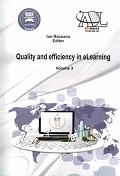COMPUTER UTILIZATION IN MOTOR ACTIVITIES – OPPORTUNITIES AND LIMITATIONS
COMPUTER UTILIZATION IN MOTOR ACTIVITIES – OPPORTUNITIES AND LIMITATIONS
Author(s): Iulian Gabriel Ghiţescu, Alina Daniela MOANȚĂ, Virgil TUDORSubject(s): Education
Published by: Carol I National Defence University Publishing House
Keywords: computer; motor activities; physical education; sports
Summary/Abstract: In our domain, the computer finds its applicability in physical education, sports, kinesitherapy, leisure motor activities etc. In physical education, it can be used in the following situations: designing and planning the activity content, preparing the didactic materials, information collecting and processing. In sports trainingr is used in the concrete activities carried out on the field and in the lab, in order to: design and plan the activities, perform the technique biomechanical analysis, monitor athletes’ reaction to the effort and analyze their health condition, control different situations, elaborate some training means, adjust the exercise conditions, control the periods of time necessary to make different measurements while the athlete is performing, evaluate athletes’ skills, collect, analyze and interpret the results. In competitive activities, the computer utilization of the sports for: recording the results, analyzing, processing and interpreting the results, analyzing athletes’ competitive performances under the physical, technical, tactical, artistic training aspects and so on. In kinesitherapy, the computer can be used to: check subjects’ health condition, adjust the exercise conditions (by establishing where it will be developed, by regulating the effort amount, intensity and complexity, by creating a feedback between the patient and the way of performing the exercise), analyze and interpret the results. In leisure motor activities, the computer is used to: monitor participants’ reaction to the effort, analyze subjects’ health condition, collect, analyze and interpret the results.
Journal: Conference proceedings of »eLearning and Software for Education« (eLSE)
- Issue Year: 9/2013
- Issue No: 03
- Page Range: 185-190
- Page Count: 6
- Language: English

